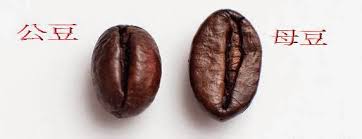Figure out how to distinguish between coffee beans and soybeans.
Before we talk about the mystery of the sex of male beans and female beans, let's first know a few things. First of all, the coffee tree itself is not divided into male and female trees. In fact, coffee flower is a plant with both male and female organs, belonging to the family Rubiaceae. The coffee bean itself is the core seed of the coffee fruit before it is roasted. It can grow on its own when it falls into the soil, even if only one tree can grow the coffee fruit. Since it is hermaphroditic, there is no difference between male and female trees, and naturally there should be no difference between male and female beans. Furthermore, the original English word of "Gongdou" is "Peaberry" or the abbreviation "PB", but it is not called "Male Beans". The word "Gongdou" is just a common name in Chinese. in fact, he has another name, "Yuandou".

Raw bean VS flat bean
Public beans (round beans) are classified as defective beans in botanical theory for several reasons: one is that coffee beans suffer from diseases and insect pests before bearing fruit, or it may be caused by coffee trees suffering from prolonged drought or malnutrition. In addition, coffee beans at the ends of branches also have a higher chance of forming round beans, which may be due to poor growth due to more opportunities to be exposed. When the normal form of coffee fruit is peeled, there are two coffee nuts (seeds) inside, called "Type-1". This is the most normal form of coffee beans, that is, the mother beans or flat beans in the theory of male and female beans. The other is the elliptical shape of "Type-2", which has only one seed, which is what we call round beans. In fact, there is only a difference in growth form between the two, not a gender distinction. The common name in Chinese is indeed easy to be misunderstood.
Some coffee lovers think that Peaberry beans have a better mellow thickness and charming aroma, and taste sweeter. In addition, because its output is relatively scarce, Peaberry has become a commercial means to be bid up and sold at a high price, but in fact, Peaberry beans are sometimes discarded because they are regarded as defective beans in some producing areas. To them, Peaberry has no commercial value to speak of.
Important Notice :
前街咖啡 FrontStreet Coffee has moved to new addredd:
FrontStreet Coffee Address: 315,Donghua East Road,GuangZhou
Tel:020 38364473
- Prev

Introduction to the flavor and taste characteristics of 90 + Hachilla coffee
The origin of the name of 90 + Hachilla: originated from the Aricha (Achilla) production series developed with S.A.Bagersh in 90 + 2006-2008. Name this coffee Hachira. Hachira coffee juice has a distinctive floral flavor, usually with elderberry or BlackBerry flavors, and sometimes with basil herbs. Origin: 90 + Ethiopia
- Next

Introduction to the flavor description of Mexican coffee beans and the taste and flavor description of Mexican coffee.
Due to geographical and climatic reasons, the coffee growing area of Mexico is close to Guatemala, and the production classification belongs to the Central American type. The main producing areas are: Kolabegu, Australia Aluca states, the products are mostly washed beans produced in the highlands, with a good aromatic and sour taste, the grade is divided into three categories according to altitude: Aldura (219m-1280 m), Prima. Rabe Society (853-1)
Related
- Guji coffee producing area of Guji, Ethiopia: Humbela, Shakiso, Wulaga
- What is the most expensive variety of Qiloso in BOP multi-variety group?
- How to store the coffee beans bought home?
- Why are Yemeni coffee beans so rare now?
- Ethiopian Sidamo all Red Fruit Sun Sun Santa Vini Coffee beans
- SOE is mostly sour? What does it mean? Is it a single bean? what's the difference between it and Italian blending?
- Is Italian coffee beans suitable for making hand-brewed coffee?
- How to choose coffee beans when making cold coffee? What kind of coffee beans are suitable for making cold coffee?
- Just entered the pit to make coffee, what kind of coffee beans should be chosen?
- Can only Japan buy real Blue Mountain Coffee? What are authentic Jamaican Blue Mountain coffee beans?

